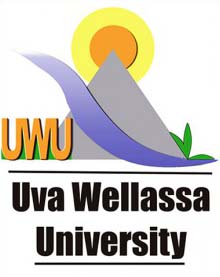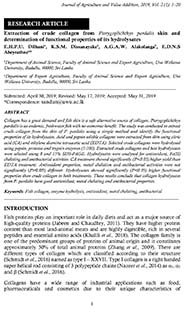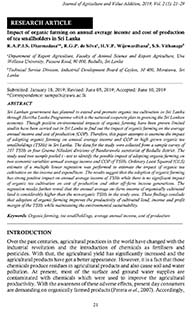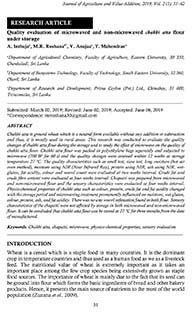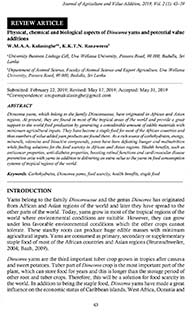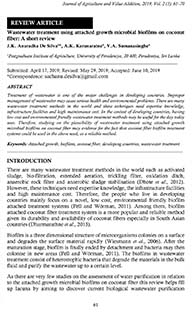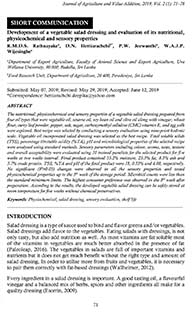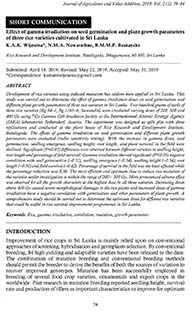
Volume 02 Issue 01
TABLE OF CONTENTS
RESEARCH ARTICLES
01. Extraction of crude collagen from Pterygoplichthys pardalis skin and determination of functional properties of its hydrolysates E.H.P.U. Dilhania, K.S.M. Dissanayakea, A.G.A.W. Alakolangab, E.D.N.S Abeyrathnea*
INFORMATION
Journal Title: Journal of Agriculture and Value Addition Volume : 2 Issue 01 Page : 1- 20
Submitted: April 30, 2019; Revised: May 17, 2019; Accepted: May 31, 2019 *Correspondence: sandun@uwu.ac.lk
ABSTRACT
Collagen has a great demand and fish skin is a safe alternative source of collagen. Pterygoplichthys pardalis is an endemic, freshwater fish with no economic benefit. The study was conducted to extract crude collagen from the skin of P. pardalis using a simple method and identify the functional properties of its hydrolysates. Acid and pepsin soluble collagens were extracted from skin using citric acid (CA) and ethylene diamine tetraacetic acid (EDTA). Selected crude collagens were hydrolysed using pepsin, protease and trypsin enzymes (1:100). Extracted crude collagens and best hydrolysates were selected using 8 and 15% SDS-PAGE. Hydrolysates were analysed for antioxidant, Fe(II) chelating and antibacterial activities. CA treatment showed significantly (P<0.05) higher yield than EDTA treatment. Antioxidant properties, metal chelation and antibacterial activities were not significantly (P>0.05) different. Hydrolysates showed significantly (P<0.05) higher functional properties than crude collagen in both treatments. These results conclude that collagen hydrolysates from P. pardalis have good antioxidant, metal chelating and antibacterial properties.
02. Impact of organic farming on annual average income and cost of production of tea smallholders in Sri Lanka R.A.P.I.S. Dharmadasaa*, R.G.P. de Silvaa, H.V.P. Wijewardhanab, S.S. Vithanageb
INFORMATION
Journal Title: Journal of Agriculture and Value Addition Volume : 2 Issue 01 Page : 21 – 29 Submitted: January 18, 2019; Revised: June 05, 2019; Accepted: June 10, 2019 *Correspondence: sampath@uwu.ac.lk
ABSTRACT
Sri Lankan government has planned to extend and promote organic tea cultivation in Sri Lanka through Haritha Lanka Programme which is the national cooperate plan to greening the Sri Lankan economy. Though positive environmental impacts of organic farming have been proven limited studies have been carried out in Sri Lanka to find out the impact of organic farming on the average annual income and cost of production (COP). Therefore, this paper attempts to examine the impact of adopting organic farming on annual average income and COP in high grown organic tea smallholdings (TSHs) in Sri Lanka. The data for the study were collected from a sample survey of 107 TSHs in four Grama Niladari divisions of Bandarawela secretariat of Badulla district. The study used two sample pooled t – test to identify the possible impact of adopting organic farming on two economic variables: annual average income and COP of TSHs. Ordinary Least Squared (OLS) estimate of a multiple linear regression was performed to estimate the impact of organic tea cultivation on the income and expenditure. The results suggest that the adoption of organic farming has strong positive impact on annual average income of TSHs while there is no significant impact of organic tea cultivation on cost of production and other off–farm income generations. The regression results further reveal that the annual average on–farm income of organically cultivated land is considerably higher than the non-organic TSHs in the study area. These findings conclude that adoption of organic farming improves the productivity of cultivated land, income and profit margin of the TSHs while maintaining the environmental sustainability.
03. Quality evaluation of microwaved and non-microwaved chakki atta flour under storage A. Inthujaa, M.R. Roshanab*, V. Anujaac, T. Mahendrana
INFORMATION
Journal Title: Journal of Agriculture and Value Addition Volume : 2 Issue 01 Page : 31 – 42 Submitted: March 02, 2019; Revised: June 02, 2019; Accepted: June 06, 2019 *Correspondence: mrroshana30@gmail.com
ABSTRACT
Chakki atta is ground wheat which is a neutral form available without any addition or subtraction and thus, it is mostly used in rural areas. This research was conducted to evaluate the quality changes of chakki atta flour during the storage and to study the effect of microwave on the quality of chakki atta flour. Chakki atta flour was packed in polyethylene bags separately and subjected to microwave (700 W for 60 s) and the quality changes were assessed within 12 weeks at storage temperature 27 °C. The quality characteristics such as smell test, sieve test, long moisture (hot air oven method), moisture using NIR (Near Infrared Ray), protein using NIR, ash using NIR, wet-gluten, fat acidity, colour and weevil count were evaluated at two weeks interval. Crude fat and crude fibre content were evaluated at four weeks interval. Chapatti was prepared from microwaved and non-microwaved flour and the sensory characteristics were evaluated at four weeks interval. Physio-chemical properties of chakki atta such as colour, protein, crude fat and fat acidity changed with the storage period and microwaving treatment prominently influenced on moisture, wet gluten, colour, protein, ash, and fat acidity. There was no any weevil infestation found in both flour. Sensory characteristics of the chapatti were not affected by storage in both microwaved and non-microwaved flour. It can be concluded that chakki atta flour can be stored at 27 °C for three months from the date of manufactured.
04. Physical, chemical and biological aspects of Dioscorea yams and potential value additions W.M.A.A. Kulasinghea*, K.K.T.N. Ranaweerab
INFORMATION
Journal Title: Journal of Agriculture and Value Addition Volume : 2 Issue 01 Page : 43 – 59 Submitted: February 22, 2019; Revised: May 17, 2019; Accepted: May 31, 2019 *Correspondence: anupamakulasinghe@gmail.com
ABSTRACT
Dioscorea yams, which belong to the family Dioscoreaceae, have originated in African and Asian regions. At present, they are found in most of the tropical areas of the world and provide a great support to the world food production by generating a considerable amount of edible materials with minimum agricultural inputs. They have become a staple food for most of the African countries and thus numbers of value added yam products are found there. As a rich source of carbohydrates, energy, minerals, vitamins and bioactive compounds, yams have been defeating hunger and malnutrition while finding solutions for the food scarcity in African and Asian regions. Health benefits, such as anticancer properties, anti-diabetes properties, boosting retinal functions and cardiovascular disease prevention arise with yams in addition to delivering an extra value to the yams in food consumption systems of tropical regions of the world.
05. Wastewater treatment using attached growth microbial biofilms on coconut fiber: A short review J.K. Anuradha De Silvaa*, A.K. Karunaratnea, V.A. Sumanasinghea
INFORMATION
Journal Title: Journal of Agriculture and Value Addition Volume : 2 Issue 01 Page : 61 – 70 Submitted: April 17, 2019; Revised: May 29, 2019; Accepted: June 10, 2019 *Correspondence: sachanu.desilva@gmail.com
ABSTRACT
Treatment of wastewater is one of the major challenges in developing countries. Improper management of wastewater may cause serious health and environmental problems. There are many wastewater treatment methods in the world and these techniques need expertise knowledge, infrastructure facilities and high maintenance cost. In the context of developing countries, having low cost and environmental friendly wastewater treatment methods may be useful for the day today uses. Therefore, studying on the plausibility of wastewater treatment using attached growth microbial biofilms on coconut fiber may evidence for the fact that coconut fiber biofilm treatment systems could be used in the above need, as a reliable method.
SHORT COMMUNICATIONS
06. Development of a vegetable salad dressing and evaluation of its nutritional, physicochemical and sensory properties R.M.D.S. Rathnayakea, D.N. Hettiarachchib*, P.W. Jeewanthia, W.A.J.P. Wijesinghea
INFORMATION
Journal Title: Journal of Agriculture and Value Addition Volume : 2 Issue 01 Page : 71 – 78 Submitted: May 07, 2019; Revised: May 29, 2019; Accepted: June 12, 2019 *Correspondence: hettiarachchi.deepika@yahoo.com
ABSTRACT
The nutritional, physicochemical and sensory properties of a vegetable salad dressing prepared from four oil types that were vegetable oil, sesame oil, soy bean oil and olive oil along with vinegar, wheat flour, curry leaf powder, pepper, salt, sugar, carboxymethyl cellulose (CMC) vitamin E, and egg yolk were explored. Best recipe was selected by conducting a sensory evaluation using nine-point hedonic scale. Vegetable oil incorporated salad dressing was selected as the best recipe. Total soluble solids (TSS), percentage titratable acidity (%TA), pH and microbiological properties of the selected recipe were analysed using standard methods. Sensory parameters including colour, aroma, taste, texture and overall acceptability were evaluated using 10 trained panelists for the selected product for five weeks at two weeks interval. Final product contained 55.2% moisture, 23.3% fat, 8.3% ash and 5.7% crude protein. TSS, %TA and pH of the final product were 18, 0.33% and 4.08, respectively. No significant (P>0.05) changes were observed in all the sensory properties and tested physicochemical properties up to the 5th week of the storage period. Microbial counts were less than the standard minimum limits. The highest consumer preference was observed in the 3rd week after preparation. According to the results, the developed vegetable salad dressing can be safely stored at room temperature for five weeks without chemical preservatives.
07. Effect of gamma irradiation on seed germination and plant growth parameters of three rice varieties cultivated in Sri Lanka K.A.K. Wijesena*, N.M.A. Nawarathne, B.M.M.P. Basnayake
INFORMATION
Journal Title: Journal of Agriculture and Value Addition Volume : 2 Issue 01 Page : 79 – 84 Submitted: April 18, 2019; Revised: May 22, 2019; Accepted: May 31, 2019 *Correspondence: kamaniwijesena@gmail.com
ABSTRACT
Development of rice varieties using induced mutation has seldom been applied in Sri Lanka. This study was carried out to determine the effect of gamma irradiation doses on seed germination and different plant growth parameters of three rice varieties in Sri Lanka. Two hundred grams of seeds of three rice varieties (Bg 94–1, Bg 1165–6, Suwandal) were irradiated varying doses of 200, 300 and 400 Gy using 60Co Gamma Cell Irradiator facility at the International Atomic Energy Agency (IAEA) laboratories Seibersdorf, Austria. The experiment was designed as split plot with three replications and conducted at the plant house of Rice Research and Development Institute, Batalagoda. The effects of gamma irradiation on seed germination and different plant growth parameters were evaluated (radio sensitivity testing). With the increase in gamma doses, seed germination, seedling emergence, seedling height, root length, and plant survival in the field were declined. Significant (P<0.05) differences were observed between different varieties in seedling height, root length and percentage of field survival. Gamma irradiation showed significant (P<0.05) negative correlation with seed germination (–0.52), seedling emergence (–0.54), seedling height (–0.54), root length (–0.50) and field survival (–0.42). Percentage of survival in the field was the least affected while the percentage reduction was 8.56. The most efficient and optimum dose to induce rice mutation of the varieties under investigation is within the range of 200 – 300 Gy. More pronounced adverse effect was observed for all the growth characters at the highest dose in all three varieties. Increasing doses above 400 Gy caused severe morphological damages to the rice plants and increased doses of gamma irradiation have a negative correlation with germination and other parameters of plant growth. A comprehensive study should be carried out to determine the optimum doses for different rice varieties that could be useful in rice varietal improvement programmes in Sri Lanka.

